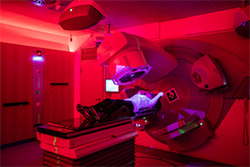Take a deep breath

One in eight women suffers from breast cancer during her life. With the help of high-precision special cameras and an innovative procedure, the Department of Radiation Oncology of the Medical Center – University of Freiburg makes the treatment of breast cancer patients even safer and more efficient. The Deep Inspiration Breath Hold (DIBH) method is based on a simple but effective trick. The patient inhales deeply, causing the chest to lift and move slightly away from the underlying heart. Special cameras are used to measure the patient's three-dimensional body surface. Only in the optimal reclining position does the high-precision irradiation begin. Now the 100th patient has been successfully irradiated under the control of the 3D scan.
"With left-sided breast irradiation, we were able to reduce the radiation exposure of the heart by about 40 percent on average, in contrast to conventional methods. That is tremendous progress," says Prof. Dr. Anca-Ligia Grosu, Medical Director of the Department of Radiation Oncology at the Medical Center – University of Freiburg. The Department is one of the leading centers for radiotherapy in Germany and Europe, with more than 2,700 patients treated per year.
Especially in breast-conserving treatment, irradiation is now indispensable. First, the DIBH method creates a computed tomography (CT) image that captures the optimal reclining and breathing position. "This CT scan then compares the system with the actual position and detects the slightest deviations that are barely visible to the human eye," says Dr. Jördis Lübke, medical physicist in the Department of Radiation Oncology of the Medical Center – University of Freiburg. Red and green light projections on the surface of the patient's body help the medical assistants to correctly position the patient. The patient receives visual feedback about the required breathing depth. This can be done using semi-transparent data glasses in which symbols help find the right depth. Alternatively, the feedback can also be via colored room light. Red light indicates a deviation, green light shines at the optimal breathing depth. When the patient holds her breath, the irradiation begins. "The procedure is extremely sensitive. As soon as the patient exhales, the radiation is stopped immediately," says Dr. Lübke.
Even if the principle of DIBH seems simple, its implementation requires a lot of experience. "Radiotherapy is an extremely effective weapon against cancer, but it is also very complex," says Prof. Grosu. That is why in the Department of Radiation Oncology, a separate medical physics section works with radiation therapists to develop the right treatment plan for every patient. "We are pleased that we have now been able to offer gentle treatment to the 100th patient," says Prof. Grosu.
Back